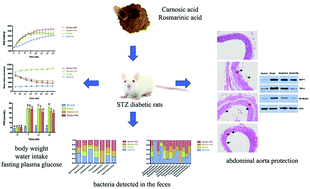Protective effect of rosmarinic acid and carnosic acid against streptozotocin-induced oxidation, glycation, inflammation and microbiota imbalance in diabetic rats
Abstract
This study evaluated the protective effects of two rosemary components, rosmarinic acid (RA) and carnosic acid (CA), against hypoglycemia, hyperlipidemia, oxidative stress and an imbalanced gut microbiota architecture in diabetic rats. Treatment with RA and CA (30 mg kg−1) decreased the levels of fasting plasma glucose (23.7%, 15.6%), total cholesterol (30.4%, 14.1%) and triglyceride (65.7%, 47.8%) at 15 weeks. RA and CA also exhibited an anti-oxidative and anti-glycative effect by lowering the formation of malondialdehyde and advanced glycation end products. In addition, they showed protective effects against tissue damage and inflammation in the abdominal aorta, based on microscopic observations and the analysis of protein expression. Finally, the prebiotic effects of RA and CA on gut microbiota were demonstrated by increasing the population of diabetes-resistant bacteria and decreasing the amounts of diabetes-sensitive bacteria. Overall, RA showed a stronger protective effect than CA in mitigating diabetic symptoms in rats.



 Please wait while we load your content...
Please wait while we load your content...